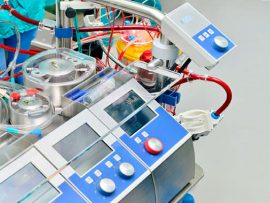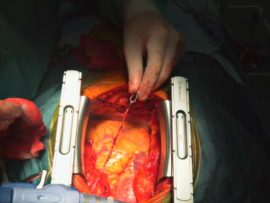Abstract Introduction: Cardiopulmonary bypass (CPB) is known to cause a systemic inflammatory and immune response. Objective: An in-vitro model of cardiotomy suction was designed to quantify the effects of incrementally increased air-blood..
Lire la suiteAbstract The desired use of the HPH Jr. is optimal due to the low priming volume; however, the lower rate of volume removal necessitates utilization of a larger hemofilter. Larger..
Lire la suiteAbstract Differential hypoxia and the arterial mixing zone are two important factors in managing peripheral veno-arterial extracorporeal membrane oxygenation (VA-ECMO). With the aim of improving perfusion to the aortic arch..
Lire la suiteSummary Background Blood transfusion has well‐documented adverse effects. As part of a blood conservation initiative at our center, we began routine use of cell saver for all congenital heart surgery..
Lire la suiteAbstract The “stone heart” syndrome is a rare but often fatal complication of cardiac surgery associated with hypertrophy of the myocardium. The mechanisms behind the syndrome are not fully understood...
Lire la suiteBleeding Complications After Use of Novel Oral Anticoagulants in Patients Undergoing Cardiac Surgery
Abstract Background The study was performed to analyze the results of and bleeding complications after administration of novel (NOAC). Methods We investigated 81 consecutive patients (median age 74 years, interquartile range [IQR]:..
Lire la suiteSURGICAL AORTIC VALVE replacement historically has been the standard of care for patients with severe, symptomatic aortic stenosis. However, up to one-third of patients with symptomatic aortic stenosis are not..
Lire la suiteAbstract Background Right heart failure (RHF) is a serious post-operative complication of left ventricular assist device (LVAD) implantation, with significant morbidity and mortality. Many clinical, hemodynamic and laboratory variables have..
Lire la suiteBackground of the HeartMate II (HM2 [Thoratec Corporation, Pleasanton, CA]) is a potentially devastating complication. While attention has been focused on strategies to prevent this complication, the impact of surgical technique..
Lire la suiteAbstract Pump thrombosis is a dreaded complication of long-term implantable ventricular assist devices. No guidance exists regarding the diagnosis and management of this entity despite its significant morbidity. After considerable..
Lire la suiteBackground Pump thrombosis is a major adverse event in patients supported with a left ventricular assist device (LVAD). Treatment approaches include device exchange, lytic therapy, or augmentation of anticoagulation or..
Lire la suiteBackground Having a preoperative small (LV) has been associated with higher complication and mortality rates after (LVAD) implantation; however, the outcomes after continuous-flow LVAD implantation have not been well studied. This is..
Lire la suiteBackground Recent data suggest that contributes to (LVAD) , but the mechanism is unknown. In a clinical study, we measured plasma free hemoglobin (pfHgb) and the incidence of LVAD thrombosis. In an in..
Lire la suiteAbstract Blood conservation measures to reduce perioperative blood loss during cardiac surgery have been a subject of focus in recent years. This is due in part to the high cost..
Lire la suiteAbstract Background and problem The WHO Surgical Safety Checklist has been shown to improve patient safety as well as improving teamwork and communication in theatres. In 2009, it was made..
Lire la suiteAbstract Background Failure to rescue (FTR) is gaining popularity as a quality metric. The relationship between patient frailty and FTR after cardiovascular surgery has not been fully explored. This study..
Lire la suiteAbstract Background Contradictory findings from randomized trials addressing similar research questions are not uncommon in medicine. Although differing results may reflect true differences in the treatment effects or in the..
Lire la suiteAbstract Background Postoperative pulmonary complications are common after cardiac surgery and have been related to lung collapse during cardiopulmonary bypass (CPB). No consensus exists regarding the effects of maintaining mechanical..
Lire la suiteRetrograde Autologous Priming in Cardiac Surgery: Results From a Systematic Review and Meta-analysis
Abstract Background: Retrograde autologous priming (RAP) before cardiopulmonary bypass (CPB) may minimize allogeneic red cell transfusion. We conducted a systematic review of the literature to examine the impact of RAP..
Lire la suiteAbstract Unfractionated heparin is the first anticoagulant drug and has been successfully used clinically for over 80 years. Heparin and its analogues are used during surgery and dialysis and are..
Lire la suiteMicrovascular Alterations During Cardiac Surgery Using a Heparin or Phosphorylcholine-Coated Circuit
Abstract Objective Heparin biocompatible coating frequently is used to reduce inflammation and blood coagulation during cardiopulmonary bypass (CPB) in cardiac surgery. Whether heparin coating is protective or damaging to the..
Lire la suiteAbstract OBJECTIVES Surgery of thoracic aortic aneurysm (TAA) is associated with blood loss and coagulopathy and a high need for red blood cell (RBC) volume. Retrograde autologous priming (RAP) decreases..
Lire la suiteAbstract Diversity and inclusion in medicine, and in surgery in particular, still merit substantial attention in 2019. With each increase in academic rank there are fewer women, with only 24%..
Lire la suiteAbstract Introduction Low oxygen delivery during cardiopulmonary bypass is related to a range of adverse outcomes. Previous research specified certain critical oxygen delivery levels associated with acute kidney injury. However,..
Lire la suiteAbstract BACKGROUND Sugammadex, which is used to reverse rocuronium-induced neuromuscular blockade, has a limited and transient effect on activated partial thromboplastin time and prothrombin time. However, no data are available..
Lire la suiteAbstract AIM This study is based on the hypothesis that the routine use of transesophageal echocardiography in cardiac surgery will influence the surgical decision taken by the surgeon intra-operatively in..
Lire la suiteAbstract This study characterizes the pharmacodynamics of antimicrobial prophylaxis and sternal wound infections following cardiac surgery. Duration of surgery and cefazolin plasma concentration during wound closure were independently associated with..
Lire la suite










